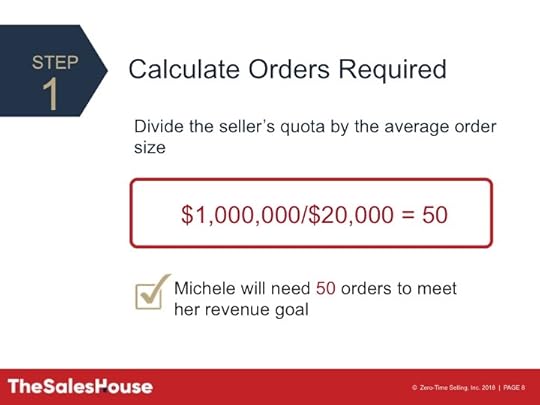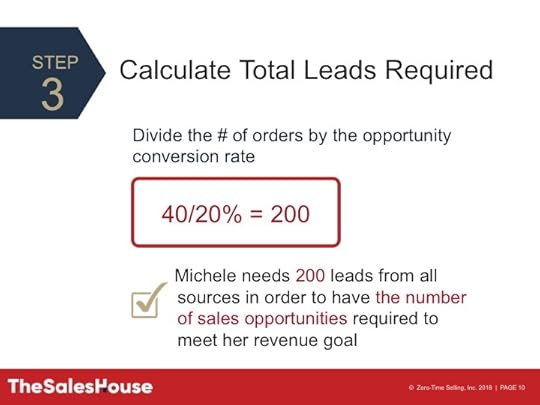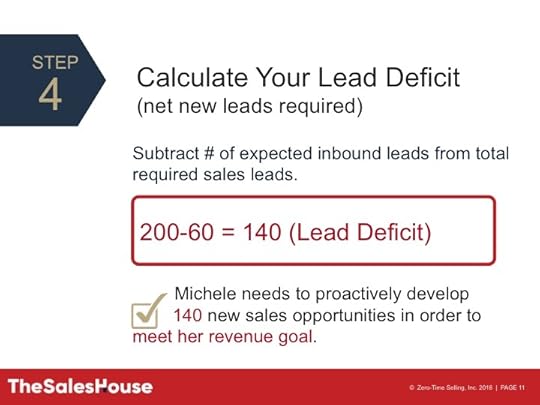Are You Running A Lead Deficit?
The most important number that every sales rep
needs to know before he or she can build an effective sales plan for the new
sales year is their Lead Deficit. To give yourself a solid chance of making
your quota you have to know this number.
Here’s how it works.
Making quota is based on winning a certain number of orders at a certain Average Order Size (or Average Sales Price.) Some percentage of those orders will come from existing accounts. The rest will come from new business opportunities. Of those new business opportunities, a certain percentage will be derived from sales opportunities generated by inbound sales leads and the rest necessarily will flow from your proactive prospecting efforts. That number of new sales leads that you need to generate through your own proactive prospecting is called your Lead Deficit.
The Lead Deficit forms the heart of your detailed sales action plan. What are the actual steps you will take each and every day to identify and connect with a sufficient number of new customer opportunities to ensure that you will achieve your quota?
What’s
Your Lead Deficit?
Here’s a simple method to calculate your Lead
Deficit and to accurately estimate the type and quantity of the sales
activities that need to be a part of your sales plan. It shouldn’t require more
than 30 minutes of your time to do this. And, I guarantee that if you are able
to close your Lead Deficit, you’ll make quota for the year.
This calculation requires some data and some
assumptions. Let’s start with the data points you need to gather.
1. What is your lead conversion rate?
Historically, what percentage of your sales leads do you convert into orders? You should know this important performance statistic by heart. If you don’t, don’t guess. Go back and calculate it based on your sales records over the past 12 months.
2. What is your Average Order Size?
This is different than your company’s Average Sales Price. You don’t want to use the average achieved by all the salespeople in your company. This is your plan. It has to be based on your track record. Therefore, you need to use your specific Average Order Size (AOS.) Again, don’t guess. Go back and look at your order book for the past 12 months and count the number of orders you closed. Divide your total sales dollars for 2014 by the number of orders you closed to get your AOS.
3. What fraction of your business did you get from existing customers?
Calculate the dollar value of the orders you received from existing customers in 2013 and 2014. Get those precise numbers from your sales records. Add those two years together and divide by 2. Then divide that number again by your Average Order Size. The result is the number of orders from existing customers that you will plug into your model.
4. How many inbound sales leads did you receive in 2014?
Go back into your CRM records and count how many sales leads you received each month for the previous 12 months. Take the lowest monthly number out of the previous 12 months to use in your model. Don’t use an average number. And don’t assume that the number of sales leads you receive is going to increase. Always use the most conservative scenario to incorporate into your model.
Now let’s build a simple model to calculate your Lead Deficit that you can use to start your planning. We’ll use sample data points I created to illustrate how it works. (There are ways to refine this model that would require more space than I have available to explain. If you want more information on how to build this model join me in The Sales House .)
.)
Let’s Look At Some Sample Data…
Lead conversion rate = 20%Average Order Size = $20,000# of orders from existing customers = 10# of inbound leads = 60 per year/5 per month
Step 1: Divide Your Quota by Your Average Order Size

Let’s assume your quota is $1,000,000 per
year. Based on the Average Order Size, you’ll need to win 50 orders in order to
achieve quota.
Step 2: Subtract Orders from Existing Customers

Subtract 10 (orders from existing customers) from 50 (total orders needed) and the result is that you’ll need to win 40 orders from new business opportunities to make your quota.
Step 3: Divide the # of Orders by Your Lead Conversion Rate

Based on your 20% Lead Conversion Rate you’re
going to need 200 total leads from all sources in order to meet your quota.
Step 4: Subtract Inbound Sales Leads from Total Required Sales Leads

Subtract 60 inbound leads from the 200 total leads required and the difference is the 140 new sales opportunities that you will need to proactively develop on your own.
In other words, your Lead Deficit is equal to 140. Based on your past performance (which is the most accurate guide to future performance,) 140 is the minimum number of sales leads that you must proactively develop in order to meet your quota.
So, before you start creating your sales plan, take a few minutes now and calculate your Lead Deficit. This is absolutely essential to enable you to answer you the primary questions in your sales plan:
What are the specific proactive prospecting activities that have to form the basis of your daily sales routine in order to develop a sufficient number of sales opportunities to eliminate your lead deficit?What are the metrics that you will use to track your progress on a weekly and monthly basis?
As a salesperson your job boils down to doing
whatever hard work is required to meet your goals. This means investing your
time to execute a disciplined prospecting process (e.g., doing some research to
pick targets, making connections online, getting on the phone, or going out and
making calls.) Which is always much easier to do when you can see the target in
plain sight.
The post Are You Running A Lead Deficit? appeared first on Andy Paul.
Andy Paul's Blog
- Andy Paul's profile
- 4 followers



